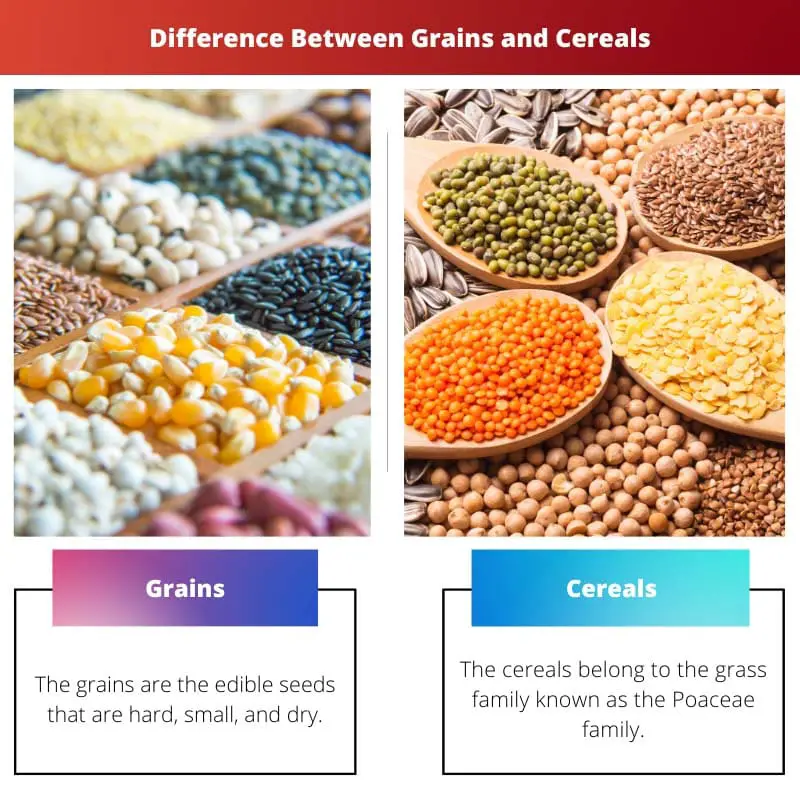Food is the most vital component of any living organism’s life, whether humans or animals. Human beings consume a wide range of fruits and vegetables for different flavours and different benefits.
Humans grow fruits and vegetables in various parts of the world using diverse methods. Unlike fruits and vegetables, grains and cereals are widely consumed and essential to many people’s diets.
Key Takeaways
- Grains are small, hard, edible seeds harvested from grass-like plants, while cereals are a type of grain that includes wheat, rice, corn, barley, and oats, which staple food sources for much of the world’s population.
- Grains can be whole, containing all three parts of the seed (the bran, germ, and endosperm), or refined, with the bran and germ removed, while cereals are consumed as whole grains or processed into various food products, like bread, pasta, or breakfast cereals.
- Grains and cereals provide essential nutrients like carbohydrates, fiber, and certain vitamins and minerals. Still, whole grains are more nutritious than refined grains due to their higher fiber and nutrient content.

Grains vs Cereals
Grains are small, hard, dry seeds that can come from a variety of plants, suitable for consumption by humans and animals. Cereals are a type of grain specifically sourced from the grass family, including wheat, rice, and corn, commonly used in breakfast foods and baking.
Comparison Table
| Parameters of Comparison | Grains | Cereals |
|---|---|---|
| Definition | The grains are the edible seeds that are hard, small, and dry. | The cereals belong to the grass family known as the Poaceae family. |
| Soil | The grains are grown in clay soil. | The cereals are easily cultivated on dried soils. |
| Durability | The grains have a shelf life of up to 6 to 8 months. | The cereals have a shelf life of about 4 months. |
| Nutritional Value | They have a good quantity of Carbohydrates, dietary fiber, and numerous B vitamins. | They’re high in vitamins, minerals, carbs, lipids, and oils. |
| Examples | legumes include chickpeas, mung beans, soybeans, lentils, and pseudocereals, such as chia and quinoa | Wheat, rice, corn, oats, barley, and millet |
What are Grains?
The grains are edible seeds that are devoured both by humans and animals directly. A grain crop is a group of plants that produce grains.
Cereals and legumes are the two types of grains that are consumed in large quantities. These grains are alluded to as “commercial grains,” and they are cultivated for profit.
The Poaceae family of grains is the first form of cereal grain. Because cereal grains are abundant in carbohydrates, they are a good source of energy.
Wheat, rice, oats, barley, rye, millet, corn, triticale, and sorghum are illustrations of cereal grains that are full of nutrients and appropriate for human utilization.
Many pseudocereals, such as chia, quinoa, and buckwheat grains, come under the grain group. Legumes, known as pulses, are the second type of grain. The pea family includes legumes.
Beans are a superior source of nourishment to cereal grains since they contain more protein. And some of the most frequently consumed and cultivated legumes include chickpeas, mung beans, soybeans, common beans, lentils, and lima beans.
Grains are regarded as a staple diet by humans all over the world due to their numerous advantages. After harvesting, they can be stored in godowns since they are more durable than other crops or food items.
These grains can be consumed whole or ground into flour. Mined flour is used to manufacture a variety of products, including bread, noodles, spaghetti, flatbreads, cakes, pastries, and more.

What are Cereals?
Cereals are grasses that belong to the Poaceae family. The Gramineae family is another name for the Poaceae family. These crops, or their grains or seeds, are farmed for human consumption in practically every corner of the world.
They supply more energy to consumers than any other human-cultivated crop.
Cereals are regarded as staple crops and are grown in large numbers in a number of countries. Cereal comes from the Latin word “Ceres,” which means “Roman Goddess of Agriculture.”
Wheat, rice, and millets are some of the most prominent cereals. Wheat is farmed in vast quantities throughout the Western world.
Rice and millets are two more types of cereals that are farmed in developing nations and consumed by millions of people. Cereals are classified as edible grains, as opposed to any other sort of plant.

Main Differences Between Grains and Cereals
- Cereals belong to the grass family and are used as grains, whereas grains are small, hard, and dry seeds gathered for human and animal nutrition.
- Carbohydrates, dietary fibre, and numerous B vitamins are abundant in grains (thiamin, riboflavin, niacin, and folate). On the contrary, cereals are high in vitamins, minerals, carbs, fats, oils, and a wide range of proteins.
- Grains refer to the seeds of legumes or cereals, but not all legumes are cereals.
- Grains are planted in clay soil. However, cereals can be produced in less rich soil as well.
- If kept intact, grains can stay for 6-8 months on the shelf, whereas cereals only last for 4 months.

- https://www.nature.com/articles/1601283
- https://www.sciencedirect.com/science/article/pii/S0367253017312070
- https://www.sciencedirect.com/science/article/pii/S1360138513002768
